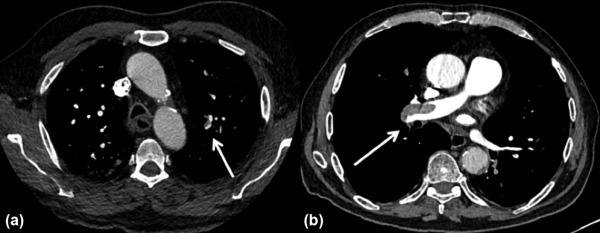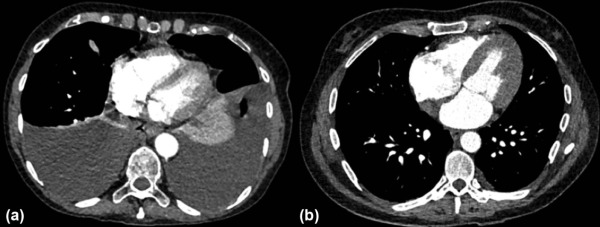Highlights
High-pitch allows for significant reduction ( P < .001) of motion artifacts.
Free breathing allows for significant reduction of Valsalva maneuver.
High-pitch provides diagnostic confidence without the need for patient compliance.
High-pitch at 80 kVp allows for significant dose reduction ( P < .001).
Rationale and Objectives
Get Radiology Tree app to read full this article<
Materials and Methods
Get Radiology Tree app to read full this article<
Results
Get Radiology Tree app to read full this article<
Conclusions
Get Radiology Tree app to read full this article<
Introduction
Get Radiology Tree app to read full this article<
Get Radiology Tree app to read full this article<
Get Radiology Tree app to read full this article<
Get Radiology Tree app to read full this article<
Get Radiology Tree app to read full this article<
Get Radiology Tree app to read full this article<
Get Radiology Tree app to read full this article<
Materials and Methods
Patient Population
Get Radiology Tree app to read full this article<
Table 1
Patient Characteristics
Total
(n = 100) SPCT-BH
(n = 50) HPCT-FB
(n = 50)P Value_Female : Male_ 47:53 20:30 27:23 —Mean age (j) 58.74(±16.9) 57.22(±16.4) 60.26 .317Mean height (cm) 170(±0.1) 172(±0.1) 1.68 .083Mean weight (kg) 70.33(±13.3) 72.56(±14.7) 68.1 .140Mean BMI (kg/m 2 ) 24.17(±3.5) 24.44(±3.6) 23.89 .248
BMI, body mass index; HPCT-FB, high-pitch computed tomography under free breathing; SPCT-BH, standard-pitch computed tomography under breath-hold.
Get Radiology Tree app to read full this article<
CT Protocols
Get Radiology Tree app to read full this article<
Get Radiology Tree app to read full this article<
Get Radiology Tree app to read full this article<
Get Radiology Tree app to read full this article<
Get Radiology Tree app to read full this article<
Radiation Dose
Get Radiology Tree app to read full this article<
Quantitative Analysis
Get Radiology Tree app to read full this article<
Qualitative Analysis
Get Radiology Tree app to read full this article<
Get Radiology Tree app to read full this article<
Get Radiology Tree app to read full this article<
Get Radiology Tree app to read full this article<
Statistical Analysis
Get Radiology Tree app to read full this article<
Get Radiology Tree app to read full this article<
Results
Radiation Dose
Get Radiology Tree app to read full this article<
Table 2
Radiation Dose
Total
(n = 100) SPCT-BH
(n = 50) HPCT-FB
(n = 50)P Value_DLP (mGy × cm)_ 160.17 223.85 96.49 <.001CTDI (mGy) 4.35 6.01 2.68 <.001SSDE (mGy) 5.39 7.41 3.38 <.001
CTDI, computed tomography dose index; DLP, dose-length product; HPCT-FB, high-pitch computed tomography under free breathing; SPCT-BH, standard-pitch computed tomography under breath-hold; SSDE, size-specific dose estimate.
Get Radiology Tree app to read full this article<
Quantitative Analysis
Get Radiology Tree app to read full this article<
Table 3
Attenuation and Noise
Total
(n = 100) SPCT-BH
(n = 50) HPCT-FB
(n = 50)P Value_Mean attenuation PA_ 410.67 342.45 478.92 <.001Mean attenuation subcutaneous fat −77 -65.33 -121.33 <.001Noise 12.76 9.59 15.94 <.001SNR 36.06 38.05 34.07 .258CNR 33.30 40.60 28.01 <.001
CNR, contrast-to-noise ratio; HPCT-FB, high-pitch computed tomography under free breathing; PA, pulmonary artery; SNR, signal-to-noise ratio; SPCT-BH, standard-pitch computed tomography under breath-hold.
Get Radiology Tree app to read full this article<
Qualitative Analysis
Get Radiology Tree app to read full this article<
Get Radiology Tree app to read full this article<
Get Radiology Tree app to read full this article<
Get Radiology Tree app to read full this article<
Get Radiology Tree app to read full this article<
Get Radiology Tree app to read full this article<
Get Radiology Tree app to read full this article<
Get Radiology Tree app to read full this article<
Get Radiology Tree app to read full this article<
Table 4
Presence of Movement Artifacts and Valsalva Artifact
SPCT-BH
(n = 50) HPCT-FB
(n = 50)P Value R1 (%) R2 (%) R1 (%) R2 (%)Breathing 94 70 36 42 <.001Heart pulsation 90 76 16 9 <.001Valsalva artifact 28 30 6 4 <.001
HPCT-FB, high-pitch computed tomography under free breathing; R1, reader 1; R2, reader 2; SPCT-BH, standard-pitch computed tomography under breath-hold.
P value between the SPCT-BH and the HPCT-FB.
Table 5
Assessability of Anatomical Structures
Heart (Chambers, Septum, Morphology) Vascular Structures (Upper Field) Vascular Structures (Middle Field) Vascular Structures (Lower Field) SPCT-BH
(n = 50) HPCT-FB
(n = 50) SPCT-BH
(n = 50) HPCT-FB
(n = 50) SPCT-BH
(n = 50) HPCT-FB
(n = 50) SPCT-BH
(n = 50) HPCT-FB
(n = 50)R1 (%)R2 (%)R1 (%)R2 (%)R1 (%)R2 (%)R1 (%)R2 (%)R1 (%)R2 (%)R1 (%)R2 (%)R1 (%)R2 (%)R1 (%)R2 (%)Nondiagnostic0__0__0__0__2__2__0__0__0__2__0__0__0__2__0__0Restricted assessment2__12__2__4__8__6__2__4__4__4__0__6__4__4__0__6Good80__60__22__28__30__32__20__22__22__30__14__16__20__30__26__20Excellent__18__28__76__68__60__60__78__74__74__64__86__78__76__64__74__74
HPCT-FB, high-pitch computed tomography under free breathing; R1, reader 1; R2, reader 2; SPCT-BH, standard-pitch computed tomography under breath-hold.
P value between the SPCT-BH and the HPCT-FB.
Get Radiology Tree app to read full this article<
Discussion
Get Radiology Tree app to read full this article<
Get Radiology Tree app to read full this article<
Get Radiology Tree app to read full this article<
Get Radiology Tree app to read full this article<
Get Radiology Tree app to read full this article<
Get Radiology Tree app to read full this article<
Get Radiology Tree app to read full this article<
Get Radiology Tree app to read full this article<
Get Radiology Tree app to read full this article<
Get Radiology Tree app to read full this article<
Get Radiology Tree app to read full this article<
Get Radiology Tree app to read full this article<
References
1. Torbicki A.: Pulmonary thromboembolic disease. Clinical management of acute and chronic disease. Rev Esp Cardiol 2010; 63: pp. 832-849.
2. Anderson F.A., Wheeler H., Goldberg R.J., et. al.: A population-based perspective of the hospital incidence and case-fatality rates of deep vein thrombosis and pulmonary embolism: the Worcester DVT Study. Arch Intern Med 1991; 151: pp. 933-938.
3. White R.H.: The epidemiology of venous thromboembolism. Circulation 2003; 107: pp. I-4-I-8.
4. Torbicki A., Perrier A., Konstantinides S., et. al.: Guidelines on the diagnosis and management of acute pulmonary embolism. Eur Heart J 2008; 29: pp. 2276-2315.
5. Wittram C., Yoo A.J.: Transient interruption of contrast on CT pulmonary angiography: proof of mechanism. J Thorac Imaging 2007; 22: pp. 125-129.
6. Kuzo R.S., Pooley R.A., Crook J.E., et. al.: Measurement of caval blood flow with MRI during respiratory maneuvers: implications for vascular contrast opacification on pulmonary CT angiographic studies. Am J Roentgenol 2007; 188: pp. 839-842.
7. Bauer R.W., Schell B., Beeres M., et. al.: High-pitch dual-source computed tomography pulmonary angiography in freely breathing patients. J Thorac Imaging 2012; 27: pp. 376-381.
8. Eckermann K., Harrison J., Menzel H.-G., et. al.: ICRP publication 119: compendium of dose coefficients based on ICRP publication 60. Ann ICRP 2012; 41: pp. 1-130.
9. Boone J., Strauss K., Cody D.: Size-specific dose estimates (SSDE) in pediatric and adult body CT examinations. Report of AAPM Task Group 2042011.
10. Gordic S., Morsbach F., Schmidt B., et. al.: Ultralow-dose chest computed tomography for pulmonary nodule detection: first performance evaluation of single energy scanning with spectral shaping. Invest Radiol 2014; 49: pp. 465-73 10.
11. Landis J., Koch G.: The measurement of observer agreement for categorical data. Biometrics 1977; 33: pp. 159-174.
12. Li X., Ni Q.Q., Schoepf U.J., et. al.: 70-kVp high-pitch computed tomography pulmonary angiography with 40 mL contrast agent: initial experience. Acad Radiol 2015; 22: pp. 1562-1570.
13. Bolen M.A., Renapurkar R.D., Popovic Z.B., et. al.: High-pitch ECG-synchronized pulmonary CT angiography versus standard CT pulmonary angiography: a prospective randomized study. Am J Roentgenol 2013; 201: pp. 971-976.
14. Lu G.M., Luo S., Meinel F.G., et. al.: High-pitch computed tomography pulmonary angiography with iterative reconstruction at 80 kVp and 20 mL contrast agent volume. Eur Radiol 2014; 24: pp. 3260-3268.
15. Sabel B.O., Buric K., Karara N., et. al.: High-pitch CT pulmonary angiography in third generation dual-source CT: image quality in an unselected patient population. PLoS ONE 2016; 11: e0146949
16. Becattini C., Agnelli G., Germini F., et. al.: Computed tomography to assess risk of death in acute pulmonary embolism: a meta-analysis. Eur Respir J 2014; 43: pp. 1678-1690.
17. Ostovan M.A., Ghaffari S., Pourafkari L., et. al.: Modification of simplified pulmonary embolism severity index and its prognostic value in patients with acute pulmonary embolism. Heart Lung Circ 2016; 25: pp. 184-190.
18. Kligerman S.J., White C.S.: Image quality and feasibility of an ultralow-dose high-pitch helical triple–rule-out computed tomography angiography acquired in the caudocranial direction. J Thorac Imaging 2014; 29: pp. 10.
19. Morsbach F., Gordic S., Desbiolles L., et. al.: Performance of turbo high-pitch dual-source CT for coronary CT angiography: first ex vivo and patient experience. Eur Radiol 2014; 24: pp. 1889-1895.
20. Gordic S., Husarik D., Desbiolles L., et. al.: High-pitch coronary CT angiography with third generation dual-source CT: limits of heart rate. Int J Cardiovasc Imaging 2014; 30: pp. 1173-1179.
21. Farshad-Amacker N.A., Alkadhi H., Leschka S., et. al.: Effect of high-pitch dual-source CT to compensate motion artifacts: a phantom study. Acad Radiol 2013; 20: pp. 1234-1239.
22. Baumueller S., Alkadhi H., Stolzmann P., et. al.: Computed tomography of the lung in the high-pitch mode: is breath holding still required?. Invest Radiol 2011; 46: pp. 240-245.
23. Zhang F., Yang L., Song X., et. al.: Feasibility study of low tube voltage (80 kV) coronary CT angiography combined with contrast medium reduction using iterative model reconstruction (IMR) on standard BMI patients. Br J Radiol 2016; 86: pp. 20150766.

